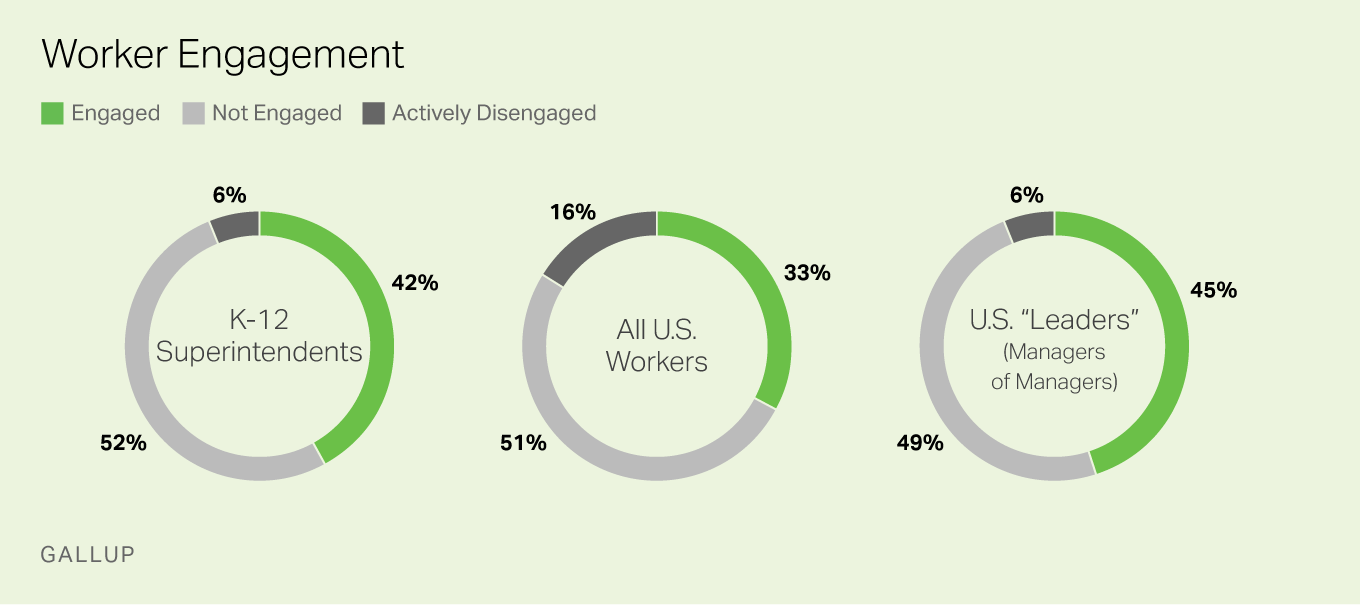
U.S. School Superintendents Have High Work Engagement

Just over four in 10 public school superintendents (42%) in the U.S. are engaged with their jobs, according to Gallup's recent survey of more than 2,300 public school superintendents about a range of key education issues. Superintendents' engagement is considerably higher than engagement among U.S. workers overall (33%) and is similar to the engagement of workplace leaders in the U.S. (45%).

Gallup measures 12 key elements of workplace engagement that are rooted in employees' performance development needs. These elements of engagement capture important information about employees' emotional and psychological attachment to the workplace. When an employee's workplace engagement needs are consistently met, the individual's performance improves across a range of key workplace outcomes. When employees are in a leadership role, their engagement has important implications for team and organizational outcomes.
Based on their responses to questions that cover the 12 elements of engagement, Gallup places employees into one of three categories:
- Engaged employees are highly involved in and enthusiastic about their work and workplace. These employees take psychological ownership for their work, going above and beyond to do what is needed to move their individual, team and organizational performance forward.
- Not engaged employees may be psychologically unattached to their work and their organization. These employees have a largely transactional relationship with their job, but because their psychological needs are not consistently met, they are limited to typical levels of performance.
- Actively disengaged employees have an unhealthy psychological relationship with their job. They aren't just unhappy at work; they're upset that their needs are not being met and often undermine the accomplishments of their more engaged colleagues.
Across the 12 elements of workplace engagement, superintendents were most likely to say that the mission or purpose of their organization makes them feel their work is important, with roughly seven in 10 strongly agreeing (giving it a "5" rating on a 1-to-5 scale) with the statement. This far outpaces the strong agreement of the typical U.S. employee (four in 10) and is slightly higher than the six in 10 found among workplace leaders -- specifically, managers of managers -- across other professions. Superintendents were also highly likely to say that their opinions count in the workplace, with seven in 10 strongly agreeing (compared with the typical employee at three in 10 and other leaders at six in 10). Superintendents were least likely to strongly agree that they have a best friend at work and that they have received recognition or praise for doing good work.
Employees' relationship with their manager is a key factor in their level of engagement. Similarly, superintendents who are positive about their relationship with their local school board are most likely to be engaged. For example, 67% of superintendents who strongly agree that their district is well-governed at the board level are engaged, compared with 41% among those who agree (give a "4" rating) and 14% among those who are neutral or disagree (give a "1," "2" or "3" rating) that their board is well-governed at the local level.
Having a board that the superintendent perceives to be knowledgeable about K-12 education is even more strongly related to superintendent engagement. Seventy-six percent of superintendents who strongly agree that their board is "very knowledgeable" are engaged with their job -- considerably more than the 57% who agree and the 26% who are neutral or disagree.
Engagement among leaders is vitally important to the health of the overall organization because they set the tone for workplace culture. Gallup finds the engagement percentage of top leaders (managers of managers) is at 45%, yet just 29% of managers of individual contributors are engaged. This varies a great deal across teams within organizations -- and is largely linked to the effectiveness of the local manager. Managers' engagement has a "cascade effect" on their teams. Workgroups with engaged managers are 59% more likely to be engaged than those led by actively disengaged managers.
In schools, this means the local school principal is a key player in setting the tone for the engagement of teachers and staff. The nation's superintendents agree. In 2016, Gallup asked superintendents to evaluate the importance of several responsibilities often assigned to school principals. At the top of the list were selecting teachers and building an engaging environment for students, followed closely by the important role principals have in building an engaging environment for teachers. The importance of building an engaging culture for teachers was ranked higher than other responsibilities, including evaluating teachers and leading curriculum and instruction.
ottom Line
Superintendent engagement is a key driver of school success. Forty-two percent of superintendents are engaged with their job -- an engagement level far above that of the typical employee and on par with the engagement of leaders in other types of organizations. Engaged superintendents have strong relationships with their boards and believe them to be knowledgeable about issues of K-12 education. While superintendent engagement is a great place to start, the challenge for district leaders is to cascade their own level of engagement throughout their organization, ensuring that their principals and, ultimately, that every employee has a great place to work.
Gallup research shows that engaged employees consistently outperform their less-engaged peers across a variety of workplace outcomes. In schools, engaged teachers are less likely to be absent, less likely to resign or retire, and more likely to receive high ratings from their principals. Maybe most importantly, engaged teachers are more likely to have engaged students and more likely to have student academic progress in their classrooms. Strong superintendent engagement is an important step in ensuring that the nation's schools are great places to work and learn.
Read the full report on Gallup's 2017 Survey of K-12 School District Superintendents.
